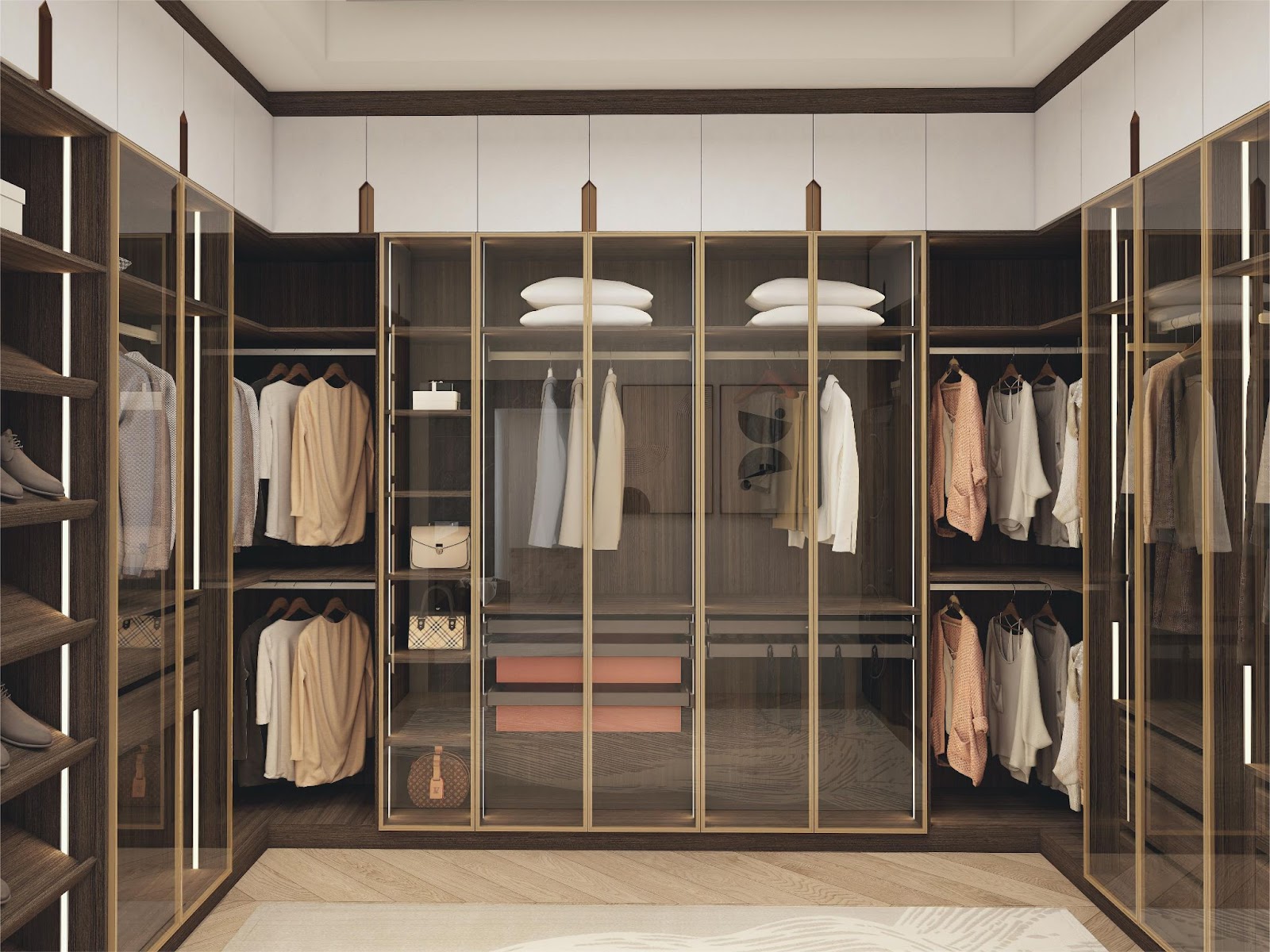Home Improvement
Walk-in Closet Dimensions: How to Design the Perfect Storage Space for Any Home?

Imagine stepping into your own personal boutique every morning—a beautifully organized space where everything has its place and getting dressed becomes a pleasure rather than a chore. That’s the magic of a well-designed walk-in closet! Whether you’re building from scratch or renovating your current space, nailing the dimensions is the secret ingredient to creating a storage sanctuary that truly works for your lifestyle.
The ideal walk-in closet requires 4×4 feet minimum for a small design, 6×6 feet for double-sided storage, and 7×10 feet for a master closet with an island, all with 30-36 inches of walkway clearance.
Let’s dive into the world of walk-in closet design and discover how to create a space that’s as functional as it is fabulous.
What Are the Standard Walk-in Closet Dimensions You Should Know?
Think of dimensions as the foundation of your closet dream—get them right, and everything else falls into place. Let’s break down the essential measurements that will set you up for success:
Minimum Dimensions for Different Layouts:
- Small Walk-in Closet: 4×4 feet (16 sq. ft.) — Cozy but mighty! Perfect for minimalists or as a secondary closet
- Standard Walk-in Closet: 6×6 feet (36 sq. ft.) — The sweet spot for solo storage with room to move
- Master Walk-in Closet: 7×10 feet (70 sq. ft.) — Spacious enough for two wardrobes without bumping elbows
- Luxury Walk-in Closet: 100+ sq. ft. — The fashion enthusiast’s paradise with room for islands, seating areas, and even a champagne fridge!
Critical Clearance Requirements:
- Walkway Width: 30-36 inches minimum — The “dance space” between storage units (ever tried changing while feeling cramped?)
- ADA Compliance: 30 inches wide by 48 inches deep clear space — Ensures accessibility for everyone
- Door Clearance: Standard door requires 24 inches — Consider space-saving sliding or pocket doors to reclaim valuable square footage
Remember, these aren’t just arbitrary numbers—they’re the difference between a frustrating daily experience and a closet that feels like it was made just for you. As the saying goes in
design: measure twice, build once!
Alt:Small walk-in closet with dark shelves, drawers, and hanging space.
How Do You Choose the Right Layout for Your Available Space?
Your closet layout should be as unique as your wardrobe. Let’s explore the main configurations and find your perfect match:
Single-Sided Layout:
Picture a hallway with storage along one wall—simple but effective. This layout needs:
- Minimum depth: 4-5 feet
- Storage depth: 24 inches (enough for hangers without crushing clothes)
- Walking clearance: 36 inches (room to step back and see your options)
This layout is perfect for narrow spaces or when you’re stealing a bit of space from a bedroom. Think of it as the studio apartment of closets—compact but completely functional!
Double-Sided Layout:
Imagine walking between two rows of boutique-style displays. This efficient design requires:
- Minimum width: 6-7 feet
- Storage depth: 24 inches on each side
- Center walkway: 30-36 inches (your morning catwalk!)
Double-sided layouts give you twice the hanging space and work beautifully in rectangular rooms. It’s like having your own clothing store aisle dedicated to your wardrobe!
L-Shaped Layout:
Think of wrapping storage around a corner, creating a cozy nook:
- Minimum dimensions: 6×6 feet
- Corner solutions: Special corner units or creative shelving
L-shaped layouts make those tricky corners work for you instead of becoming dust-collecting dead zones. They’re perfect for awkward spaces or creating distinct zones for different types of clothing.
U-Shaped/Wrap-Around Layout:
Envision being surrounded by your wardrobe on three sides—like a clothing hug! This design needs:
- Minimum dimensions: 7×7 feet
- Walking clearance: 36 inches in the center (your stage)
This layout maximizes every available wall, creating distinct zones for different clothing types. It’s the ultimate “everything at your fingertips” design.
Island Layout:
Picture your favorite boutique with a stunning display island in the center:
- Minimum room size: 10×10 feet (this is luxury territory!)
- Island clearance: 36 inches all around (for easy browsing)
- Island dimensions: Typically 3×4 feet minimum
Islands aren’t just stunning centerpieces—they provide valuable drawer storage for accessories, folded items, or even a jewelry display area. They’re the cherry on top of a dream closet!
Alt:Spacious luxury walk-in closet with double-sided hanging storage, open shelves, and built-in drawers.
What Storage Components Will Solve Your Specific Storage Problems?
Just as a chef needs the right tools, your closet needs components specifically designed for your wardrobe. Many homeowners work with companies like PA Kitchen that bring their expertise in custom cabinetry to whole-home storage solutions, creating perfectly tailored spaces.
Hanging Space Dimensions:
- Double-rod configuration: Positioned at 40 inches and 80 inches from the floor—perfect for separating shirts from pants
- Single rod height: 72 inches from the floor—ideal for dresses, coats, and longer garments
- Rod depth clearance: 24 inches minimum—nobody wants crushed or wrinkled clothes!
- Rod length: Maximum 3 feet per section—longer rods sag in the middle (fashion disaster!)
Shelving Dimensions:
- Standard shelf depth: 12 inches for folded clothes, 14 inches for bulkier items like sweaters and bags
- Shelf spacing: 12-14 inches between shelves—allowing you to see and grab items without disturbing the stack
- Shoe shelves: 6-7 inches in height, with angled designs that showcase your collection like works of art
Drawer Dimensions:
- Standard drawer height: 5-7 inches for delicates, 9-11 inches for bulkier items like sweaters
- Drawer width: 24-30 inches—wide enough to see everything at a glance
- Drawer depth: 14-16 inches—deep enough to be useful without becoming a black hole for lost socks
Specialty Storage:
- Jewelry drawers: Velvet-lined 2-3 inch drawers with dividers—no more tangled necklaces!
- Tie/belt racks: Pull-out designs that display each piece individually—like your personal accessories gallery
- Shoe cubbies: Individual homes for your favorite pairs, sized 6-7 inches in height, 9-12 inches in width
Think of these components as puzzle pieces that, when fitted together perfectly, create the picture of organized bliss. The right dimensions ensure everything has a home, making your morning routine smoother than your favorite silk blouse.
Alt:Elegant walk-in closet with glass wardrobe doors, open display shelves, and a built-in vanity with mirrors.
How Can You Overcome Common Dimensional Challenges?
Even Cinderella’s closet probably had a few awkward corners! Here’s how to turn challenges into opportunities:
Small Space Solutions:
- Vertical maximization: Use every inch from floor to ceiling—like urban architecture that builds upward when there’s no room to expand outward
- Adjustable systems: Install shelving that can change as your wardrobe evolves—flexibility is your friend!
- Door real estate: Transform the back of doors into organizing powerhouses with hooks and slim racks
- Pull-down magic: Install rods that bring high storage down to your level—like having an assistant hand you that special occasion outfit
Awkward Space Strategies:
- Sloped ceilings: Turn these challenging areas into shoe showcases or drawer space—what seems like a design flaw becomes a feature!
- Windows: Frame them with shelving to create a focal point—natural light makes choosing outfits easier anyway
- Pillars or obstructions: Build custom storage around them—like a city developing around natural landmarks
- Electrical outlets: Transform necessity into convenience with integrated charging stations for your devices
Shared Closet Harmony:
- Clear boundaries: Create distinct zones that prevent wardrobe border disputes
- Height customization: Install rods at different heights to accommodate varying clothing lengths—harmony through personalization
- Multiple entrances: Consider separate access points for larger shared closets—like having your own private boutique entrance
- Labeled territories: Use clear organization systems to maintain peace in shared spaces
With creativity and smart planning, challenges become the very elements that make your closet unique and perfectly suited to your space.
How Can You Future-Proof Your Walk-in Closet Design?
A truly brilliant closet design grows with you like a good friendship. When exploring options for a walk-in closet, consider these forward-thinking strategies:
Adjustable Systems:
- Choose closet systems with movable shelving and rods—like a Transformer for your storage needs
- Install tracks that allow for easy reconfiguration as seasons and fashion trends change
- Use modular components that can be added, removed, or repositioned—building blocks for your evolving style
Smart Technology Integration:
- Plan for motion-activated lighting that welcomes you into the space—no more fumbling for switches
- Include strategically placed electrical outlets for steaming, charging, or other wardrobe maintenance
- Consider automated systems for hard-to-reach storage—bringing that top shelf down to you with the press of a button
Sustainable Materials:
- Select durable, high-quality materials that age beautifully—investment pieces for your home
- Choose environmentally friendly options like formaldehyde-free boards—good for your clothes and the planet
- Opt for energy-efficient LED lighting that highlights your collection while being kind to your utility bills
A thoughtfully future-proofed closet adapts to changing fashions, technologies, and lifestyles—remaining the perfect fit for years to come.
Alt:Walk-in closet featuring built-in LED lighting, open shelving, and hanging space for clothes.
Conclusion
Creating your dream walk-in closet isn’t just about following standard dimensions—it’s about designing a space that celebrates your personal style while making everyday life more beautiful and efficient. When planned thoughtfully, your closet becomes more than storage—it’s a daily ritual space that helps you put your best foot forward.
Whether you’re carving out a modest 4×4 space or designing a boutique-worthy dressing room, the principles remain the same: plan for comfortable movement, customize storage to your specific collection, and create a design flexible enough to evolve as your style does. Your perfect closet is waiting to be built—one well-measured dimension at a time!
FAQs
What is the minimum size for a walk-in closet?
The absolute minimum size for a functional walk-in closet is 4×4 feet (16 square feet), though 5×5 feet provides much more comfort—think of it as the difference between coach and business class!
How much clearance do I need between shelves and hanging rods?
Allow 12-14 inches between shelves for folded clothes and at least 24 inches of depth for hanging clothes—your garments need breathing room just like you do!
Can I put a walk-in closet in a small bedroom?
Yes, but consider whether the trade-off is worthwhile. Sometimes a brilliantly designed reach-in closet provides better overall living space than squeezing in a tiny walk-in.
How do I maximize corner spaces in L-shaped closets?
Corner spaces transform from awkward to amazing with specialized corner shelving units, lazy Susans for accessories, or angled drawers—turning design challenges into storage opportunities.
What’s the ideal walk-in closet depth for hanging clothes?
A minimum depth of 24 inches for the hanging section plus 30-36 inches for walkway clearance creates the perfect total depth of 54-60 inches—room for your clothes AND you!
How high should closet rods be installed?
Standard heights are 40 inches from the floor for the lower rod in a double-hang section and 80 inches for the upper rod. For single rods, 72 inches gives most garments the perfect hang space.
Is a walk-in closet worth the investment?
Absolutely! Beyond increasing home value, a well-designed walk-in closet reduces daily stress, protects valuable clothing investments, and transforms the start of each day from chaotic to calm—making it one of the most satisfying home improvements you can make.
Home Improvement
Revolutionize Garden Care with Aiper Store Australia Irrigation Controllers

The contemporary homeowner is gradually resorting to technology to ease the maintenance of the gardens. Aiper Store Australia has an irrigation controller that can provide a smart way of making sure that the lawns, gardens, and outdoor plants are watered without the presence of constant supervision.
The operation of Irrigation Controllers.
An irrigation controller is a device that is used to automate the process of watering the garden on the basis of timers, sensors, and, in some cases, in connection with weather data. These systems contrast with the manual sprinklers, which are unable to analyze the conditions of the soil, temperature, and rainfall to identify the best watering times.
Even other models give the homeowner the option of having a tailored watering schedule for every zone of the garden so that the delicate flowers, vegetable beds, and lawns get the correct amount of water.
Intelligent and Pragmatic Features.
The current irrigation controllers have functions that put management of gardens beyond the automation level. These include:
- Weather-Adaptive Watering: The controller is able to postpone or adjust watering according to rain or alterations in temperature.
- Mobile App Integration: Homeowners will be able to use smartphones or tablets and monitor and control the system remotely.
- Zone-Based Management: There are various gardens that can be programmed to deliver water in a personalized manner.
- Usage Tracking: Some systems monitor water use, which allows the user to know how to conserve resources.
A smart irrigation controller with these features will minimize waste, conserve time, and provide plants with year-round growth.
Installation and Setup
The installation of an irrigation controller from Aiper Store Australia is supposed to be easy. The majority of the systems can be integrated with the existing garden sprinkler systems, which will require some slight adjustments.
Homeowners can determine zones, schedules, and calibrate sensors during installation, depending on the type of plant and soil properties. Numerous models come with guides and app tutorials to ensure that the setup process is as smooth as possible, eveforto those unexposed to the smart gardening technology.
Utilized Advantages to Homeowners.
The benefits of an irrigation controller are not limited to convenience. With automated watering, the soil can be kept in the right proportions, hence the plants are also healthy. Excessive or insufficient water is also minimized, and this minimizes the stress that plants are under, as well as the disease risk that may arise.
These devices are time-saving as busy homeowners will not have to spend hours each week watering their lawns. Gardens are given meticulous care even when they are on vacation or when they are away on long leaves, and they still grow healthy without any form of interference.
Environmental Impact
Conservation of water is a significant issue in Australia. The Violet Smart irrigation controllers by Aiper Store Australia will enable homestead owners to save on water by administering it only where and when necessary.
This accuracy lowers runoff and evaporation in addition to promoting sustainable gardening. Besides that, reduced consumption of water usually comes at a lower cost saving, making such systems a friendly and cost-effective solution for the environment.
Enhancing Home Value
A smart irrigation system can also increase property value. Maintained gardens demonstrate attractiveness and are a good indicator that the house has modern, energy- and resource-saving technology.
Landscaping is made to stay green and healthy with an irrigation controller that makes it easier to keep the curb appeal all year round. This technology is the best solution for homeowners who may want to have convenience coupled with the improvement of their properties.
Conclusion
Aiper Store Australia is an irrigation controller that is a contemporary solution to smart gardening. These gadgets make it simple to control the maintenance of gardens without physical interference by automating the watering schedules, adjusting them to the weather conditions, and providing remote control, which, in turn, enhances sustainability.
A smart irrigation controller offers a beneficial and efficient solution to the homeowner who also wants efficiency, convenience, and a healthier outdoor environment without spending a lot of energy maintaining his or her lawns and gardens.
Home Improvement
Heritage Event Venue Malaysia: Whitehouse @ The Estate on Federal Hill

In Malaysia’s vibrant event scene, finding a venue that seamlessly combines historical charm with modern amenities can be a challenge. Whether you are planning a corporate gathering, a wedding, or a private celebration, the right venue can make all the difference in creating a memorable and successful event. Whitehouse @ The Estate on Federal Hill stands out as one of Malaysia’s premier heritage event venues, offering a perfect blend of classic architecture, contemporary facilities, and unique spaces such as The Great Hall and a scenic Sky Balcony. Its distinctive character, versatility, and professional support make it an ideal choice for both corporate and personal events, from corporate event venue KL to wedding venues in Kuala Lumpur.
The Appeal of a Heritage Venue
Heritage venues offer a distinct ambiance that modern spaces often cannot replicate. Whitehouse @ The Estate is located in the historic Federal Hill area, boasting beautifully restored architecture, high ceilings, intricate woodwork, and elegant colonial detailing. This heritage charm provides a sophisticated backdrop that elevates any occasion, whether it is a professional conference or a social celebration.
Guests immediately notice the unique atmosphere, which combines history with elegance. The warm and inviting environment, complemented by features such as the garden view terrace, fosters meaningful interactions, enhances the aesthetic of events, and creates a lasting impression—key factors for any successful gathering.
Perfect for Corporate Events
For companies seeking a prestigious corporate event venue in KL, Whitehouse @ The Estate offers a combination of charm, practicality, and professional support. Its versatile spaces are suitable for a wide range of corporate functions, including meetings, seminars, workshops, product launches, and conferences.
Why Corporate Clients Choose Whitehouse @ The Estate:
- Flexible Spaces: Multiple halls and private rooms, including The Great Hall, can be adapted to the size and format of the event.
- Modern Technology: High-speed internet, audiovisual equipment, and climate-controlled rooms ensure smooth presentations and communication.
- Professional Staff: A dedicated team assists with planning, logistics, and on-site coordination, providing peace of mind for organizers.
The combination of heritage architecture and modern facilities ensures that corporate events at Whitehouse @ The Estate are both impressive and functional. Clients benefit from a setting that encourages creativity, engagement, and professional interaction while leaving a lasting impression on attendees.
Ideal for Weddings
In addition to corporate events, Whitehouse @ The Estate is a sought-after wedding venue Kuala Lumpur. Couples seeking a venue with character and elegance find it to be the perfect canvas for their dream wedding. Its timeless architecture, versatile halls, and charming outdoor areas like the Sky Balcony allow for both intimate ceremonies and grand celebrations.
Highlights for Wedding Hosts:
- Historic Ambiance: The heritage charm provides a romantic and elegant backdrop for photos and ceremonies.
- Customizable Layouts: Spaces can be adapted to accommodate guest lists of all sizes and seating arrangements.
- Full-Service Support: The venue’s team assists with décor, catering, and logistics, ensuring a stress-free planning process.
Couples appreciate how Whitehouse @ The Estate combines classic elegance with practical modern amenities, making it a reliable and stylish choice for hosting a truly unforgettable wedding.
Versatility for Every Occasion
One of the defining features of Whitehouse @ The Estate is its versatility. It is equally suitable for corporate gatherings, weddings, private parties, and social events. Its multiple halls, private rooms, and outdoor terraces can be configured for different themes, group sizes, and event formats, offering unparalleled flexibility.
- Corporate Functions: Board meetings, seminars, workshops, and networking events.
- Private Celebrations: Birthdays, anniversaries, and milestone parties.
- Weddings: Intimate ceremonies or lavish receptions.
This adaptability, combined with the venue’s heritage charm, makes Whitehouse @ The Estate one of the most sought-after heritage event venues in Malaysia, capable of hosting a wide range of events with elegance and sophistication.
Modern Facilities for a Seamless Experience
While celebrated for its heritage appeal, Whitehouse @ The Estate also provides all the modern amenities required for smooth event execution. Climate-controlled rooms, advanced audiovisual systems, high-speed internet, and catering facilities ensure every event runs seamlessly.
Whether it is a corporate presentation requiring professional technology or a wedding needing precise coordination of dining and entertainment, the venue’s modern facilities complement its classic charm perfectly. Guests experience both comfort and sophistication, enhancing the overall quality of the event.
Creating Lasting Memories
Whitehouse @ The Estate is not just a venue—it is a place where memories are created. Its historic architecture offers stunning backdrops for photography and video, while the thoughtfully designed spaces ensure that every guest feels comfortable and engaged.
For corporate events, this creates a professional yet inspiring atmosphere that strengthens connections and fosters collaboration. For weddings, it provides a romantic and elegant setting that couples and their guests will remember for years to come.
Why Whitehouse @ The Estate Stands Out
Several factors make Whitehouse @ The Estate a leading choice among heritage event venues in Malaysia:
- Heritage Architecture: Timeless design elements create an elegant and memorable ambiance.
- Versatile Spaces: Multiple halls, private rooms, and outdoor terraces accommodate a wide range of event types and sizes.
- Modern Amenities: Advanced technology, catering options, and climate-controlled spaces ensure smooth operations.
- Professional Team: Dedicated staff assist with planning, logistics, and execution, guaranteeing a seamless experience.
- Central Location: Conveniently located in Federal Hill, Kuala Lumpur, making it accessible for guests from across the city.
These features combine to provide a venue that delivers both prestige and practicality, appealing to businesses and couples alike.
Conclusion
Whether you are planning a corporate meeting, wedding, or private celebration, Whitehouse @ The Estate on Federal Hill exemplifies the perfect blend of heritage charm and modern functionality. As a premier corporate event venue in KL and wedding venue in Kuala Lumpur, it offers versatile spaces, professional support, and a unique atmosphere that elevates every event.
By choosing Whitehouse @ The Estate, organizers and couples alike can ensure that their gatherings are not only successful but also memorable, leaving a lasting impression on guests. Its combination of classic elegance, modern amenities, and exceptional service makes it one of Malaysia’s most distinguished heritage event venues, ideal for every occasion.
Home Improvement
4013hwbc Explained: A Simple, Helpful Guide for Everyone

Introduction
Understanding strange codes can feel hard. Some look like model numbers. Some act like error codes. Others are batch labels or part IDs. The code “4013hwbc” is one of those codes. It looks technical, but it does not have to be scary. This guide breaks it down in clear steps. You will learn how to identify it. You will learn where to look for trusted information. You will learn how to install, use, maintain, or troubleshoot it. The goal is simple. Keep you safe. Save your time. Help you make smart choices with less stress and more confidence.
What Is 4013hwbc?
A code like this can mean many things. It might be a product model. It could be a part number. It may show on a label, a sticker, or a screen. Some brands use letters for series. They use numbers for version or size. You can treat 4013hwbc as a pointer. It points to something real. That “something” could be a device, a component, or a specific build. Your job is to match the code to its context. The context tells you the meaning.
How to Identify the Context Fast
Start with where you saw the code. Was it on a box, a device, or an app? Was it printed near a barcode or QR code? Was it in a manual or a receipt? Write this down. Take a clear photo if you can. Note the brand name near the code. Note any nearby words like “model,” “SKU,” or “serial.” Context clues make things clear. If the code appears on a screen, record the steps that showed it. Context plus steps help support teams confirm the purpose.
Where to Find Trustworthy Information
Always start with the brand’s official sources. Check the user manual or quick start guide. Look for the support page on the brand’s website. Search the product catalog or parts catalog. Scan any QR codes on labels. Check invoices or warranty cards. If you cannot find official details, ask the seller. Ask for a data sheet, a spec sheet, or a compatibility chart. Use forums with care. Look for answers from verified staff or trained technicians. Keep a record of every source you used.
Reading Labels, SKUs, and Barcodes the Right Way
Many labels include more than one code. A SKU tracks stock. A serial number is unique to one unit. A model number identifies a type. A batch or lot number marks production. Barcodes and QR codes store this data. If 4013hwbc sits near a barcode, scan it. Many phones can scan natively. Some labels include safety marks and compliance icons. Common marks include CE, UL, FCC, and RoHS. These symbols show testing and safety standards. They protect you and your home.
If 4013hwbc Is a Product Model: What to Check
Treat it like a model number first. List key specs that matter to you. Check size, weight, power, and voltage. Check materials and finishes. Check warranty and service options. Review compatibility with your system or space. Confirm accessories, cables, and mounting options. Compare the model to the next version up and down. This shows tradeoffs. Look at total cost of ownership. That includes parts, energy use, and maintenance. If something feels unclear, ask for a spec sheet in writing.
If 4013hwbc Shows as an Error Code
Start simple. Power cycle the device. Let it rest for one full minute. Check cables and connectors. Reseat them firmly. Look for dust, moisture, or damage. Update firmware if it is safe to do so. Restore default settings only if you have backups. Note the exact time the error appears. Note tasks running at that time. If the error repeats, log every step you take. Share the log with support. Clear logs help teams spot patterns fast and fix them safely.
Safety, Warranty, and Compliance Essentials
Safety comes first. Read the safety section of the manual before use. Confirm voltage and current ratings match your outlet. Use surge protection where needed. Keep devices dry and well ventilated. Do not open sealed parts during the warranty period. That can void coverage. Check compliance marks for your region. Make sure accessories meet the same standards. Keep proofs of purchase. Keep serials and model numbers handy. Good records make warranty claims faster and easier.
Buying or Replacing Parts Labeled 4013hwbc
When buying, match the code exactly. Small changes can cause big issues. Confirm dimensions, connectors, and firmware. Ask sellers about returns and restocking fees. Use payment methods with buyer protection. If replacing a part, compare old and new units side by side. Confirm label details line by line. Test in a safe, low-risk setup first. Never force a fit. Do not bypass safety locks or fuses. If something feels off, stop and contact support before continuing.
Installation and Setup Best Practices
Plan your setup before you start. Clear the workspace. Gather tools, fasteners, and manuals. Use a checklist you can follow step by step. Mount devices on solid surfaces. Route cables cleanly with no sharp bends. Label each cable at both ends. Power up only when all connections are secure. Perform a basic function test. Update firmware if the guide says so. Document everything with photos. Good documentation saves time during future upgrades or repairs.
Maintenance That Extends Lifespan
Simple care can add years of use. Keep vents clear. Wipe dust with a dry cloth. Avoid harsh cleaners. Check connectors twice a year. Look for loosened screws. Listen for odd noises. Watch for smells or heat spikes. Keep firmware current when safe. Schedule reminders for filter changes or battery checks. Store spares in a dry, cool place. Track service dates in a simple log. Small, regular checks prevent big failures and surprise costs.
Documentation Templates You Can Use Today
Create a one-page record for each device. Include model, serial, and purchase date. Add seller, price, and warranty length. Keep a photo of the label. List all accessories. Note firmware versions and change history. Keep installation photos and wiring diagrams. Track issues and fixes. Store receipts and support emails. Back up this record in the cloud and locally. Use the same template every time. Consistent records make teams faster and reduce mistakes.
Talking to Support: Scripts and Smart Questions
Be clear and kind. Share the exact code you see. Say when it appears and what you tried. Ask for the safest next step. Ask about risks and warranty impact. Request a case number. Confirm promised timelines. If you get new steps, repeat them back. This avoids confusion. Ask for a summary email. Keep that email with your records. If the fix fails, reply on the same thread. This keeps the history together and speeds resolution.
Common Pitfalls and Myths to Avoid
Do not guess at a code’s meaning. Guessing can damage parts or void warranties. Do not mix random parts because they “almost fit.” Tolerance differences matter. Do not ignore safety labels. They exist for a reason. Do not skip firmware notes. Some updates are critical or mandatory. Do not assume a forum post applies to you. Your model or region may differ. Always match your exact code, like 4013hwbc, before you act. Precision prevents risk and waste.
Real-World Scenarios That Mirror Your Situation
Imagine you find a code on a small board. It sits near a connector. You see a QR code beside it. You scan the code and learn it is a sub-assembly. The code helps you order the right replacement. Or picture a blinking screen that shows a code after updates. You follow a safe reset plan. You reseat cables. You document each step. Support sees your log and spots a pattern fast. Clear steps turn stress into control and real progress.
Search Smarter and Filter the Noise
Search engines can drown you with results. Start with the brand and the exact code. Put quotes around the code. Add words like “manual,” “datasheet,” “wiring,” or “firmware.” Try “compatibility,” “dimensions,” or “installation guide.” Look for PDFs or pages on the official site. Check dates on posts. Recent info is best for software and firmware. Save good links in a notes app. Keep a short list of trusted sources you can reuse.
A Simple Checklist for 4013hwbc
Identify where you saw the code. Capture photos of labels. Record nearby brand names. Match the code to model, SKU, or batch. Search the official site first. Confirm specs, safety marks, and warranty notes. Plan your installation. Label cables. Test in a safe state. Keep a one-page device record. Schedule maintenance. Contact support with clear logs if needed. This checklist reduces risks. It makes your process calm, steady, and repeatable.
Quick Glossary of Helpful Terms
Model number identifies a product type. Serial number is unique to a unit. SKU tracks inventory for sellers. Batch or lot points to production runs. Firmware is device software stored inside hardware. Datasheet explains key specs for parts. Compliance marks show safety testing and legal status. RMA means return merchandise authorization. Compatibility means parts work together safely. Lifecycle means the time from install to retirement. Knowing these terms speeds every task.
Accessibility and Ease-of-Use Tips
Keep text large and high contrast in your notes. Use plain language in labels. Color-code cables and storage bins. Use icons for quick scanning. Combine photos and short captions. Record voice notes if typing is hard. Store templates in shared folders for teams. Add alt text to images. Keep critical steps at the top of your checklists. Simple design helps everyone. It also reduces errors during stressful moments or handoffs.
Sustainability and Responsible Disposal
Think about the full life of your device. Choose parts that last and can be serviced. Keep packaging for returns. Reuse it when shipping RMAs. Recycle e-waste at certified centers. Wipe or destroy data on smart parts before disposal. Donate working gear to schools or labs. Buy from vendors with repair guides and parts access. Responsible choices protect your budget and the planet. Plan for end-of-life the day you install.
Security Basics You Should Not Skip
If your device connects to a network, change default passwords. Use strong passphrases. Update firmware on a planned schedule. Disable services you do not need. Segment devices on your router if possible. Back up configurations. Log admin actions. If you see odd behavior, disconnect from the network first. Then investigate in a safe state. Security is not extra. It is a key part of reliability and trust.
FAQ 1: What does 4013hwbc usually stand for?
It is a compact code. It often marks a model, part, batch, or error. The exact meaning depends on where you found it. If it sits on a device label, treat it as a model number. If it appears on a screen, it might be an error status. If it sits beside a barcode, it could be a SKU or lot code. Match the code to the context before you act. That simple step prevents wrong orders and risky fixes.
FAQ 2: How do I confirm the exact specifications?
Start with official sources. Use the manual, the product page, and the data sheet. Look for dimensions, power, connectors, and firmware notes. Check compatibility lists. Ask the seller for written confirmation if unsure. Save the document. Compare specs with any older unit you own. Match labels line by line. If anything conflicts, stop and ask support to clarify. Written proof protects your warranty and your safety.
FAQ 3: What if I cannot find a manual or datasheet?
Do not give up. Contact the brand’s support team. Share photos of the label and your notes. Ask for a PDF manual and a spec sheet. If you bought from a dealer, ask them too. Provide your order number and date. Check for region differences. Some models vary by market. Keep the reply email in your records. You will need it for future service or returns. Good paperwork saves stress later.
FAQ 4: How can I troubleshoot safely at home?
Start with power off. Unplug before touching connectors. Ground yourself to avoid static damage. Inspect for dust, heat, or corrosion. Reseat cables firmly. Power on and test one change at a time. Document each step. If the device gets hot or smells odd, stop. Seek help. Never bypass a fuse or safety switch. If you feel unsure, wait for a trained technician. Your safety matters more than speed.
FAQ 5: Is it okay to use alternatives or “close” parts?
Use caution. Similar is not the same. Connectors may match, but tolerances can differ. That can cause overheating or failure. Always match the exact model or a listed compatible part. Ask the brand for an approved replacement list. Keep that list in your records. If a seller pushes a “close” part, request written compatibility. If they refuse, find another source. Protect your device and your warranty.
FAQ 6: How should I store spares and documents?
Use clear, labeled bins with dividers. Keep parts in anti-static bags if needed. Add a small card with model, date, and source. Store manuals and receipts in a shared folder. Keep photos of labels and wiring. Add version history for firmware. Review the kit twice a year. Discard damaged items. Update labels. A tidy kit reduces downtime and panic. You will thank yourself later when time is tight.
Conclusion: Your Next Step Starts Now
You now have a clear path. You know how to read labels. You know how to search, verify, and act. You can install, maintain, and troubleshoot with confidence. Keep your one-page record close. Share it with your team or family. If you still feel stuck, return to the checklist. Or reach out to the brand with your notes and photos. If your journey centers on 4013hwbc, you can move forward today with calm, safe steps. Your careful approach will pay off in time, money, and peace of mind.
-

 Technology3 years ago
Technology3 years agoIs Camegle Legit Or A Scam?
-

 Travel3 years ago
Travel3 years agoNEW ZEALAND VISA FOR ISRAELI AND NORWEGIAN CITIZENS
-

 Technology3 years ago
Technology3 years agoRNDcoin: Korea’s first blockchain project and a world-class cryptocurrency
-

 Uncategorized3 years ago
Uncategorized3 years agoAMERICAN VISA FOR NORWEGIAN AND JAPANESE CITIZENS
-
Lifestyle1 year ago
A Guide to Silverdaddies: What You Need to Know
-

 Fashion1 year ago
Fashion1 year agoGoda Perfume Reviews: Is It Worth Your Investment?
-

 Health3 years ago
Health3 years agoHealth Benefits Of Watermelon
-

 Home Improvement9 months ago
Home Improvement9 months agoArtificial Grass Designs: Perfect Solutions for Urban Backyards














